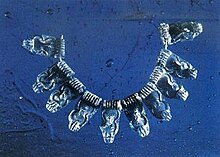Utilisateur:Albane46/Brouillon








GORDES - MUSEUM OF GLASS AND STAINED GLASS WINDOWS
The magic of glass, born from fire
- circa 400000 BC: Man takes possession of natural fire
- 26000 BC : Man masters fire. Surrounded by mammoths, in the heart of Europe , in
Dolni Vesonice, man invents the first furnace, the reverberatory furnace,
which was to be reinvented some 22000 years later in the Middle East .
The heat rises and is sent towards the centre of the furnace thanks to clay –
covered logs buried vertically in the oven . This disposition created the first
clay arch furnace which can produce a temperature of 800°C and allows the
baking of clay objects .
28000 years before, man had created the first ceramic object . Not as a
useful daily object, but to make the very symbol of life: a Venus, “mother of
men” .
- 20000 BC : An extreme glaciation destroys man’s inventions and any possibility of
progress.
- from 18000 BC: Warmer periods alternate with colder ones.
- 10000 BC The last warm period starts which still continues today .The Middle East
becomes more hospitable .
- 9000 BC Man becomes a potter . Abundant malleable clay near the rivers is used to
make vases and pots for the comfort of daily life.
These potters are the Egyptians, alongside the Nile,
the Mesopotamians along the Euphrate
the Greeks and Phenicians on the edge of the Mediterranean ,
All keen craftsmen, protected and inspired by their gods who guide their
observations. After saying their prayers, Mother Earth allowed them to use its
riches .
Their intelligence and sensibility lead them to new discoveries and new
experiments. Their expert hands shape objects of great fragile beauty.
Born from the Earth, they belong to the Universe .
- 5000 BC They discover glass, the stone of fire
- 3500 BC : After millennia of observation, they realize glass is made of sand and vegetal
ashes. Potters discover on the inside face of the furnace this strange opaque
substance, liquid when hot, solid , hard and shiny when cooled. Tinted with
blue from azurite, it imitates lapis lazuli
- 1200 BC In Memphis, in Thebes, Egyptian craftsmen of the same trade have gathered in
various districts . Dyers work next to glassmakers. One of the dyers dyes his
wool pink with the help of a black stone ground into powder. By accident, a
small quantity of the power falls into the melted glass of his neighbour , and to
their surprise, the glass becomes translucid . This“ glassmaker’s soap” is
manganese dioxide brought back from Mount Sinai with slabs of turquoise .
- 100 BC Potters blow on the fire in the furnace through hollow bamboo stalks . One of
them drops his blow pipe into the pot of molten glass. To rid his pipe of the
molten glass , he blows. The gather is inflated, it can be manipulated. Flattened ,
it becomes a translucid disc, a ‘cive‘ .The gather is blown, elongated, it becomes
“a muff” which is opened to make a pane.
Glass has really been born
The Epic of Glass can start … 5th C AD
The grand path to the study of matter is now open .
Combining a balloon and a test tube , Synesius invents the alambic.
Alcohol by distillation of wine is discovered.
There follows an obscure period impregnated with ill- digested mysticism. If the tools remain, the recipes are lost . They reappear after a few centuries , swaddled in a jumble of alchemist formulas reserved for the initiated and devoid of any rigour.
XIIth C
Abbot Suger of St Denis, launches a sumptuous and inventive use of glass . To open up the church to light, he creates the buttress. Grisaille, powdered glass paint fired into glass, brings to life the prophets from the Bible and the saints from the New Testament. Stained glass windows are born .
A century later, stained glass enhances Gothic architecture . The stone structure of the Ste Chapelle in Paris is no more than a web-like decor. The wall is made of glass: it is a wall of light. The “curtain wall” was invented eight centuries before modern architects named it so .
XVIth C
Glass is used to magnify, to look into space …
It shatters the rigid organisation of the cosmos .
Galileo invents the telescope. The earth is round and it revolves around the sun .
The microscope reveals a world unsuspected until then.
XVII th C
1610 The invention and the making of the test tube
Because of its flexibility it can be shaped as wished for experiments and for industry .
Chemistry and Physics become sciences in their own right.
Every experiment can be repeated and visually ascertained .
1630 Torricelli invents the barometer .
1640 Pascal invents his paradoxical machine and studies pressure in fluids
1650 Otto de Guericke invents the vacuum pump .
Imagination plays its dynamic role.
Experimental precision ensures rigour and controls hasty speculation .
XVIIIth and XIXth C
1766 Ramsden captures the electricity produced by rubbing a crystal disc.
1878 Edison combines the effects of the vacuum pump and of the crystal disc. In a glass bulb, he creates a vacuum. He introduces a carbon filament linked to copper wires through which an electric current passes . In a vacuum, the carbon becomes incandescent but does not burn.
The electric bulb will transform our way of living.
Thanks to glass, man can live, invent and work night and day .
Over 7000 years, the glass bead has given way to glass fibre .
Television has invaded the earth, the world has been revealed to Mankind.
Glass ceramic protects the space shuttle when it re-enters the atmosphere.
Photovoltaic cells transform sunlight into electricity without polluting and open up a new limitless era .
GLASS UNITES WHAT IT SEPARATES
NO OTHER MATERIAL HAS SUCH A CAPACITY
